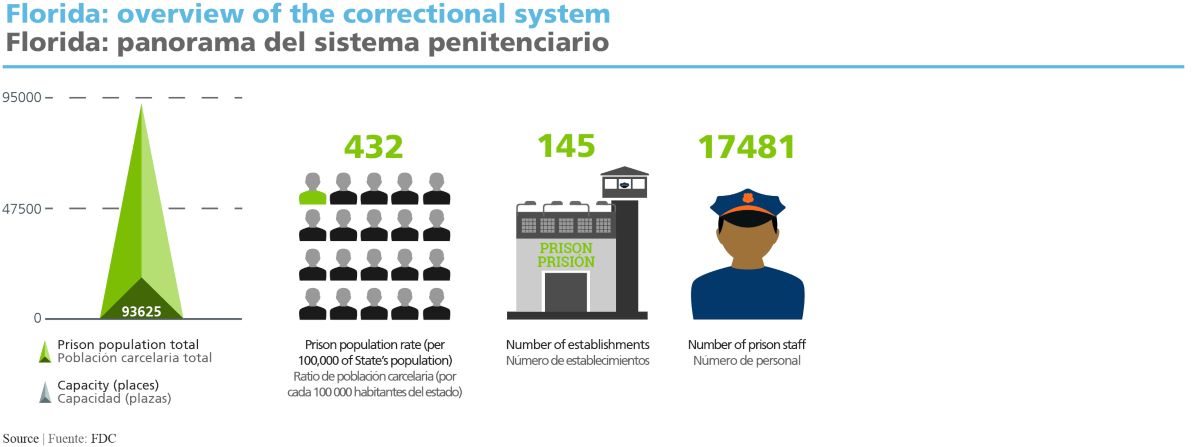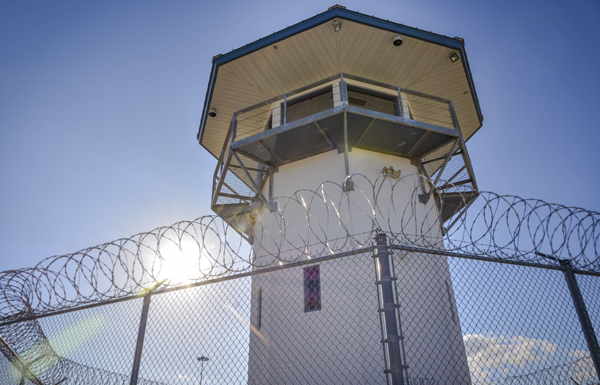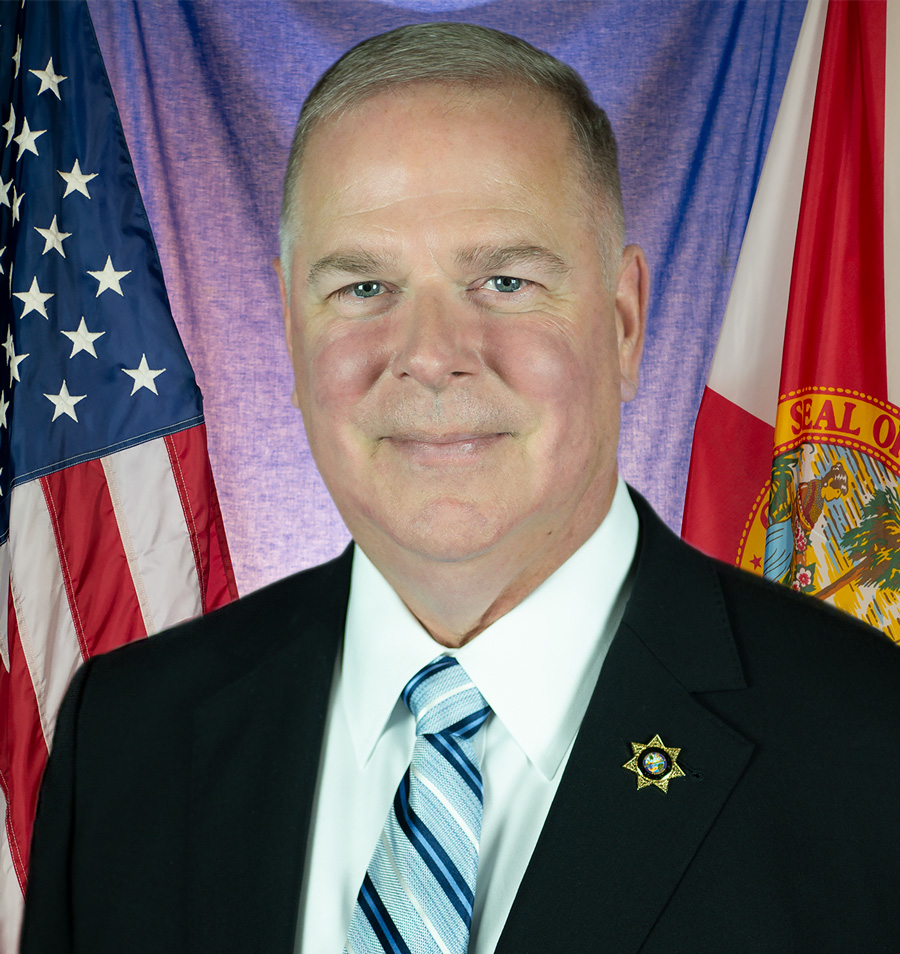Interview
Mark S. Inch
Secretary of the Florida Department of Corrections, The United States of America
JT: The United States of America has the highest incarceration rate in the world, with 2,121,600 arrestees/inmates of which 1,228,800 are in state prisons. The correctional system of Florida is the third largest of the country with nearly 94,000 inmates, incarcerated in 145 facilities across the state, and nearly 164,000 offenders on active community supervision (probation). Florida has one of the highest incarceration rates in the United States at over 500 per 100,000, and prison population projections point to a growth in the coming years, reaching almost 97,000 prisoners in 2025.
How is the Florida Department of Corrections addressing the reality shown by these figures?
MI: Thank you for the opportunity to contribute to your magazine. I have enjoyed reading it over the years. Two years ago, I would have thought that I would be talking to you about the United States Federal Bureau of Prisons, but here we are talking about the Florida Department of Corrections. Life is funny that way. As one of Florida’s newest citizens, I smile at the thought of answering your first set of statistical observations and question. Let’s see how much I’ve learnt in one year about my new state.
The Florida Department of Corrections (FDC) is the third largest prison system in the United States—true—but Florida is also the third largest state and growing. Given the size of our state, the prison population is not an outlier. The rates per 100,000 are misleading, as Florida is a wonderful holiday destination and, unfortunately, some of the 126.1 million visitors we host each year break our laws. A better statistic to ponder is that 80% of the 164,000 offenders on community supervision have never been incarcerated in our prisons, showing a propensity of the courts to seek community alternatives to incarceration. But in the end, FDC does not control who is sent to prison; that decision rests solely with the courts, consistent with our laws and statutes. And even though we gain 900 new state citizens a day from the colder and higher taxed states to the north, both our prison and probation population has actually declined over the last five years.
For our part, FDC’s number one priority is public safety. As with any correctional system, we support public safety and the broader criminal justice system through the recognisable terms of retribution, incapacitation, deterrence and rehabilitation. To that mission, I add and emphasise restoration, which is the intentional act of the corrections agency to work with communities to facilitate re-entry and restore returning citizens to their communities. In our system, approximately 85% of inmates with us today will eventually return to their communities. We take the mission of preparing them for this return quite seriously.
In the year since my appointment as Secretary, FDC has prioritised the expansion of academic and career and technical education within Florida’s prisons. We certainly have the demonstrated capability, with a series of exceptional programmes, but it is the overall capacity that we have to address into the future. Equipping inmates with the skills they need to succeed after they leave state custody is key to reducing recidivism, reducing the revictimisation of Florida’s communities and reducing the costs associated with incarceration. But let us not forget that recidivism rates are more a metric of a community’s willingness to accept, integrate and provide employment to their returning citizens, than it is a critique of the corrections agency’s programming or the criminal justice system at large.

The Florida Department of Corrections (FDC) is the third largest prison system in the United States – true – but Florida is also the third largest state and growing. Given the size of our state, the prison population is not an outlier.
JT: In the fiscal year 2017-2018, 3.4% of the Corrections Department budget was spent on education and programmes for the inmates, against a 66.8% expenditure on security and institutional operations. Florida has cut back on penal initiatives such as drug rehabilitative services, medical care, transitional housing, and re-entry programmes. Moreover, there appears to be a substantial staff problem, mostly the lack of prison officers and the exhaustion of those working in custodial duties.
How has it been for you to manage the Department’s budget and resources, particularly the staff? And what do you need in order to implement a reform?
MI: One of the important tasks I had during my first year as Secretary was to assess the impact that past financial resourcing levels and personnel management decisions had on the agency, and to propose a new way ahead. My predecessor had worked hard to stabilise the system after repeated resource reductions. There were consequences, both predictable and some unintended. The result of my review and analysis is reflected in our Governor’s budget recommendation to the State Legislature. This year we are working to address four primary challenge areas to improve our operations: reducing staff attrition and vacancy rates; reducing inmate violence, addressing inmate addiction and idleness; curbing rising health care costs; and addressing aging infrastructure.
The 2020 recommendations include targeted retention incentives for correctional and probation officers to lower the current high turnover rates and incentivise experienced staff to continue their public safety career. Additionally, we are requesting authority and funding to initiate a pilot programme to convert one third of Florida’s correctional facilities from 12- to 8.5-hour shifts. FDC correctional officers have been on 12-hour shifts for nearly eight years. Numerous national studies outline the detrimental effect of 12-hour shifts on the performance and health of the staff. With 8.5-hour shifts (which allows an overlap between shifts), it is my intention to address both officer fatigue and well-being, and create safer conditions for both staff and inmates. If approved, we would then move forward with converting the remaining facilities in future years.
Correctional departments across the nation are experiencing many of the same staffing challenges. Currently, FDC’s attrition rate is unsustainable. In 2019, Governor DeSantis signed legislation expanding our applicant base for correctional officers to address staffing shortages by changing the minimum age requirement for a correctional officer from 19 to 18 years of age. I spent a thirty-five-year career in the military leading 18-year-old men and women in some very difficult environments, so I am very comfortable with that decision. The FDC has an excellent new officer training programme and exceptional leaders. If we change the work environment and pay incentives, I am confident we will reduce our staff vacancies at a steady rate, even in this period of low unemployment and overall economic prosperity.



To what extent do efforts in the Florida state correctional system lead to the rehabilitation and social reintegration of offenders (both in custody and the community), including the impact on reoffending and reincarceration rates?
MI: I certainly agree with prevailing views that providing treatment and programming to inmates and offenders is one of the strongest components in reducing recidivism. It is equally critical to the safe operation of our institutions. We are absolutely committed to expanding the programmes we offer inside our prisons and this is a key priority for our agency. Let me give a few examples of expanded programmes in the Governor’s budget recommendation to the Florida Legislature this year.
Governor DeSantis recommended $4 million to expand career and technical education. This provides funding for an increase in local technical/state colleges and industry training partnerships to expand inmate vocational opportunities by 40 additional programmes. These programmes will provide a number of vocational and industrial certificates. The Governor has also recommended $1.4 Million and 17 staff positions to expand academic programmes state-wide. The primary emphasis of this expansion will be on basic adult education and completion of high school equivalent certification. Specifically, this will allow more than 1,500 additional inmates to access educational programming at any given time.
This year, FDC successfully partnered with 19 universities and colleges to expand educational programme opportunities for inmates. These programmes include agriculture, business, construction and architecture, hospitality and tourism, culinary arts and other classes. One programme that I’m particularly excited about is the Second Chance Pell Grant Programme. The programme is a partnership between FDC and Florida Gateway College, using Federal funding. In May 2019, 47 inmates graduated from this college-level programme at Columbia Correctional Institution. Of the 47 programme participants, 43 graduated with honours.
Our Community Corrections Division implemented a Merit Based Activity programme, which rewards and supports positive behaviour for offenders sentenced to community control. The programme offers activities to motivate offenders to comply with conditions of supervision and accept responsibility for change. Community Corrections staff also conducted 92 resource and career fairs to assist offenders on probation in gaining employment.
Just recently, Governor DeSantis announced the formation of the Florida Foundation for Correctional Excellence. The specific purpose of this foundation is to link private organisations and businesses that see formerly incarcerated returning citizens as part of their future to fund and develop programmes, training and re-entry efforts. Our Governor specifically said, “We have to do more to get inmates ready for release – ready to be employees and to be productive members of our communities. The Florida Foundation for Correctional Excellence will bring public and private sector partners together to take our efforts to the next level.” It is good to have a Governor that “gets it.”
I list these examples to further express how focused we are on creating the conditions to help reduce recidivism and prepare individuals returning to their families and neighbourhoods. But again, though recidivism rates are often used as a metric to grade corrections agencies, in truth, they are a metric on a community’s willingness to accept their returning citizens. Previously incarcerated citizens have an unemployment rate five times the national average. There must be a willingness to provide ongoing services for treatment and integration, and most importantly, an opportunity for meaningful employment, to get a returning citizen back on the path to success.



What role can the Department of Corrections play in pursuing those recommendations? And, what is your opinion specifically regarding drug-related offenses: to what extent do you think that the slowdown in the prosecution of drugs, minor drug-related crimes (with the adoption of approaches that are more social, health and prevention-focused), and non-violent crime would be beneficial for Florida’s criminal justice system?
MI: We appreciate the hard work of the Legislature and partners who recognise the unique mission and challenges FDC and our state faces to address addiction and dependency disorders. Our duty as corrections professionals is to keep Florida’s communities safe and provide inmates with the tools they need for a successful transition back into their communities.
Drug and alcohol addictions and disorders have a significant impact in a prison environment. It is a complex issue that we study and address quite diligently. Of the 28,000 new admissions last year, more than half needed some level of substance use treatment. We are currently building our capacity to more quickly and effectively treat substance use and employ best practices.
Often, substance abuse and mental health disorders go hand in hand. The percentage of co-occurrence with mental health disorders in our system is about 25%, so we are looking at what treatment defines an acceptable continuum of care. A part of that is the expansion and refining of our mental health treatment resources, including construction of a new mental health hospital at Lake Correctional Institution, in central Florida.
But allow me to offer a personal perspective on the debate. I generally default to a victim’s approach to addressing what is a just level of punishment for drug related crimes. Our system rarely incarcerates inmates with mere possession or minor drug-related crime. The majority of those we incarcerate are involved in distribution or possession of large quantities of drugs, coupled with weapons or other serious felony charges. Integral to this crime category is the fact that there is a victim at the end of the supply chain. It is hard to talk to a parent of a child that overdosed on drugs, or the victim of an armed robbery tangential to purchasing drugs, and not feel the seriousness of the crime.
But a victim’s approach is not so simple, because in the balance of what is just retribution, is a recognition of the forgotten victims of crime, the family members of the incarcerated. Then add the life experience of the felon. I have spoken to so many inmates over the years that have told personal stories of being a victim, and the impact of trauma in their personal emotional development and life-skills, or lack thereof. It is just not a very easy issue to talk about in simple terms, when we keep the victims foremost in the discussion.



Of the 28,000 new admissions last year, more than half needed some level of substance use treatment. We are currently building our capacity to more quickly and effectively treat substance use and employ best practices.
JT: The Florida Department of Corrections Strategic Plan 2018-2022 states the goal of employing technology and innovation to improve operational efficiency
What and in what areas would technologies be useful and advantageous within the state’s correctional system?
MI: I was not here when that particular plan was drafted, but I sure do have an appreciation for the innovation and solutions-based strategies that come from the business sector. As Florida’s largest state agency, technological and infrastructure improvements are, by their very nature, large projects. The outlay of funding can often result in future year savings and near-term improvements in operations and safety. The challenge is prioritisation. That challenge requires detailed planning and assessment.
This year, we were gratified when Governor DeSantis included funding for security enhancement equipment and facility maintenance and repairs in his budget recommendations to the Legislature. It targets the purchase of critical equipment such as netting systems for contraband throw-overs, metal detectors, radios, location tracking systems, intercoms for mental health units, cell phone detectors, drone detection systems, ID verification systems, warehouse x-ray inspection systems, perimeter cameras, perimeter motion lights and Rapid ID for visitors.
Over and above these exciting technological improvements, we are also focusing considerable resources on facility maintenance and repairs. FDC is responsible for the repair and renovation needs of 145 facilities statewide, which equates to more than 22 million square feet of space.
FDC is responsible for the repair and renovation needs of 145 facilities statewide, which equates to more than 22 million square feet of space.
What is your expectation for the future regarding Florida’s correctional system?
MI: Having the privilege of serving our State and this agency, and interacting with the FDC staff daily, I am proud to lead this organisation into what I anticipate will be a very bright future. This first year has been both personally and professionally satisfying. Though we have much to do and some significant issues to address, we are on the right trajectory and have great support from our new Governor and the Legislature. The women and men of our agency display character, competence and commitment, and are corrections professionals. I have been in this profession since 1986 and have worked in many large, complex organisations in challenging environments. I know what right looks like, and I see a lot of right! We look forward to building on the achievements gained this year and will continue to improve our operations and measures of performance and effectiveness in the upcoming years.
Florida has a proud corrections tradition and has led the nation in contributing to the creation of national accreditation standards of correctional excellence. We were one of the first states to receive system-wide accreditation by the American Correctional Association in 1981. We still hold that accreditation to this day!
As a former military officer, I was proud to serve with the values-based Soldiers of the U.S. Army for 35 years. Here, as Secretary of Corrections, I am equally proud to serve alongside the values-based Correctional Officers, Correctional Probation Officers and staff of our agency. I have observed over the last year men and women of character – officers who demonstrate respect, integrity, courage, selfless service and compassion.
Mark S. Inch
Secretary of the Florida Department of Corrections, The United States of America
Mark S. Inch was appointed the Secretary of Corrections in January 2019. Major General (Ret) Inch previously served as a Military Police Officer for 35 years and held other key positions including, Chief of the Military Police Corps Regiment/Commandant. Following his military career, Secretary Inch served as the ninth Director of the Federal Bureau of Prisons in 2017-2018. He received a Bachelor of Arts degree in Biblical Archaeology, a Master of Arts in Geography and a Master of Military Arts and Science in Military Operational Art and Science Studies. He completed professional certification with the American Correctional Association and was the first association ember to earn the Certified Corrections Executive designation with Honour. He also received the American Correctional Association’s highest honour, the E.R. Cass Award for lifetime achievement in Corrections.”


